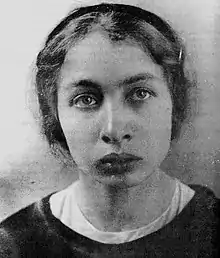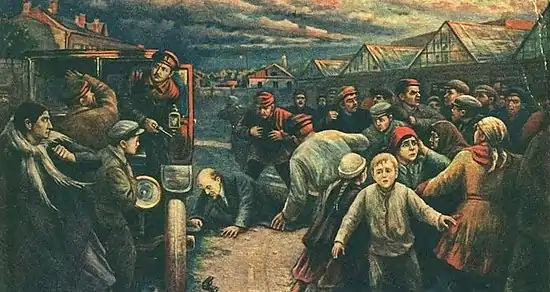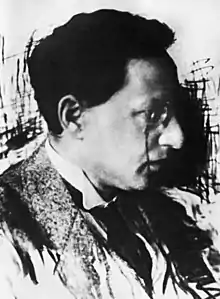Fanny Kaplan
Fanny Efimovna Kaplan (Russian: Фа́нни Ефи́мовна Капла́н; real name Feiga Haimovna Roytblat, Фейга Хаимовна Ройтблат; February 10, 1890 – September 3, 1918) was a Russian-Jewish woman, Socialist-Revolutionary, and early Soviet dissident who was convicted of attempting to assassinate Vladimir Lenin and executed by the Cheka in 1918.
Fanny Kaplan | |
|---|---|
 | |
| Born | Feiga Haimovna Roytblat February 10, 1890 |
| Died | September 3, 1918 (aged 28) |
As a member of the Socialist Revolutionary Party (SRs), Kaplan viewed Lenin as a "traitor to the revolution" when the Bolsheviks enacted one-party rule and banned her party. On August 30, 1918, she approached Lenin as he was leaving a Moscow factory, and fired three shots, badly injuring him. Interrogated by the Cheka, she refused to name any accomplices, and was executed. The Kaplan attempt and the Moisei Uritsky assassination provoked the Soviet government to officially reinstate the death penalty, which had previously been abolished under the Provisional Government in March 1917.
Biography
Relatively little is known for certain about Kaplan's background. She was born into a Jewish family. Her father was a teacher and she had seven siblings.[1] There has been confusion about her full name. Vera Figner (in her memoirs, At Women's Katorga), stated that Kaplan's original name was Feiga Khaimovna Roytblat-Kaplan (Фейга Хаимовна Ройтблат-Каплан). However, other sources have stated that her original family name was Roytman (Ройтман) – corresponding to the common German/Yiddish surname Reutemann (רויטמאן). She was also sometimes known by the given name Dora.[2]
Kaplan was home educated and soon left home to work as a milliner in Odessa.[1] She became a political revolutionary at an early age and joined a socialist group, the Socialist Revolutionaries (SRs). In 1906, when she was 16 years old, Kaplan was arrested in Kiev over her involvement in a terrorist bomb plot – she was captured after a bomb she and her romantic partner were working on accidentally exploded[3] – and committed for life to the katorga (a hard-labor prison camp). She served in the Maltsev and Akatuy prisons of Nerchinsk katorga, Siberia, where she lost her sight (partially restored later). She was released on March 3, 1917, after the February Revolution overthrew the imperial government. As a result of her imprisonment, Kaplan suffered from continuous headaches and periods of blindness.[4]
Kaplan became disillusioned with Lenin some time around 1917, as a result of conflict between the SRs and Bolsheviks.[5] The Bolsheviks had strong support in the soviets; however, in elections to a competing body, the Constituent Assembly, the Bolsheviks failed to win a majority in the November 1917 elections and a Socialist Revolutionary was elected president in January 1918. The Bolsheviks, favoring soviets, ordered the Constituent Assembly to be dissolved. By August 1918 conflicts between the Bolsheviks and their political opponents had led to the banning of most other influential parties – most recently, of the Left Socialist Revolutionaries (Left SRs), who had been the Bolsheviks' principal coalition partner for some time, but had organized the Left SR uprising in July because of their opposition to the Treaty of Brest-Litovsk. Kaplan decided to assassinate Lenin because she considered him "a traitor to the Revolution".[6]
Assassination attempt

On August 30, 1918, Lenin spoke at the Hammer and Sickle, an arms factory in south Moscow.[7] As Lenin left the building and before he entered his car, Kaplan called out to him. When Lenin turned towards her, she fired three shots with a Browning pistol.[2] One bullet passed through Lenin's coat, the other two struck him: one passing through his neck, puncturing part of his left lung, and stopping near his right collarbone; the other lodging in his left shoulder.[2][8]
Lenin was taken back to his living quarters at the Kremlin. He feared there might be other plotters planning to kill him and refused to leave the security of the Kremlin to seek medical attention. Doctors were brought in to treat him but were unable to remove the bullets outside of a hospital. Despite the severity of his injuries, Lenin survived. However, Lenin's health never fully recovered from the attack and it is believed the shooting contributed to the strokes that incapacitated and eventually killed him in 1924.[9]
Execution
There are contradictory stories of her capture. According to the testimony of Deputy Commissar S. N. Batulin, he was within 20 steps of Lenin when he heard three shots and saw Lenin face down on the ground. Afterwards, he identified a woman whom he felt looked suspicious and detained her. This turned out to be Kaplan.[10] However, factory commissar N. I. Ivanov claimed to have arrested her after she was identified by several children who had followed her down the street.[1]:439 During interrogation by the Cheka, she made the following statement:
My name is Fanya Kaplan. Today I shot Lenin. I did it on my own. I will not say from whom I obtained my revolver. I will give no details. I had resolved to kill Lenin long ago. I consider him a traitor to the Revolution. I was exiled to Akatui for participating in an assassination attempt against a Tsarist official in Kiev. I spent 11 years at hard labour. After the Revolution, I was freed. I favoured the Constituent Assembly and am still for it.[11]
When it became clear that Kaplan would not implicate any accomplices, she was executed in Alexander Garden, the order was carried out by the commander of the Kremlin, the former Baltic sailor P. D. Malkov and a group of Latvian Bolsheviks[12] on September 3, 1918 with a bullet to the back of the head.[2] Her corpse was bundled into a barrel, and set alight. The order came from Yakov Sverdlov who, just six weeks before, had ordered the execution of the tsar and his family.[13] Because there were no remains, rumors of her survival in Siberian labor camps persisted for years.[1]:442
Culpability
Grigory Semyonov, a military commander in the SR who later turned state's evidence against the group, testified in 1922 that Kaplan had been a member of his organization and that he regarded her as the "best person to carry out the attack on Lenin".[3][14]
Some historians such as Dmitri Volkogonov, Arkady Vaksberg, and Donald Rayfield have questioned the actual role of Kaplan in the assassination attempt. Volkogonov suggests "it is more likely" that Kaplan was actually not the culprit, and describes her assassination attempt as "another of the many mystifications of Bolshevik history".[15] Vaksberg states that Lidia Konopleva, another SR, was the culprit, believing it would be all too comforting that Lenin narrowly avoided being assassinated by a woman whose personality is so far from the stereotype of a national hero.[16] In particular, it is suggested that she was working on behalf of others and after her arrest assumed sole responsibility. The main argument put forth in this and other versions is her near-blindness, as well as the fact that none of the witnesses actually saw her fire the gun.[15][17] Another argument points to the contradiction between the official Soviet account and official documents, in particular a radiogram by Yakov Peters, which mentions the arrest of several suspects instead of just one. Furthermore, the bullet removed from Lenin's neck after his death was found to have been fired from a weapon other than the one Kaplan had.[3][18] Semion Lyandres goes so far as to argue that Kaplan was not even a SR.[1]:433
Legacy

Despite her refusal to name any accomplices, in the official announcement of the assassination attempt, Sverdlov blamed the Right SRs, although they themselves denied any involvement.[1]:432 Moisei Uritsky, People's Commissar for Internal Affairs in the Northern Region and head of the Cheka in Petrograd, had been assassinated nearly two weeks prior to the attack on Lenin.[19] While the Cheka did not find any evidence linking the two events, their occurring so close together appeared significant in the context of the intensifying civil war. The Bolshevik reaction was an abrupt escalation in the persecution of their opponents.[11]
An official decree announcing the Red Terror was issued only hours after the Kaplan shooting, calling for all-out struggle against enemies of the revolution.[20] In the next few months, about 800 Right SRs and other political opponents of Bolsheviks were executed. During the first year, the scope of the Red Terror expanded significantly.
In fiction
In the 1939 Soviet film Lenin in 1918 directed by Mikhail Romm, Natalia Efron portrayed Kaplan. In the 1934 Hollywood film British Agent directed by Michael Curtiz, Corinne Williams and Zozia Tanina portray Kaplan. In the German (FRG) TV series "Bürgerkrieg in Rußland" (1967), Peggy Parnas portrays Frani Kaplan. The event is also portrayed in Reilly, Ace of Spies, a 1983 British TV series. Kaplan has been the subject of or character in several plays including (Fanny Kaplan by Venedikt Yerofeyev; Kill me, o my beloved! by Elena Isaeva) and books (Europe Central by William T. Vollmann).
See also
References
- Lyandres, Semion (Autumn 1989). "The 1918 Attempt on the Life of Lenin: A New Look at the Evidence". Slavic Review. Cambridge University Press. 48 (3): 432–448. doi:10.2307/2498997. JSTOR 2498997.
- Donaldson, Norman; Donaldson, Betty (January 1, 1983). How Did They Die?. Greenwich House. p. 221. ISBN 9780517403020.
- Sixsmith, Martin (February 1, 2017). "Fanny Kaplan's Attempt to Kill Lenin, August 1918". In Brenton, Tony (ed.). Was Revolution Inevitable?: Turning Points of the Russian Revolution. Oxford University Press. pp. 175–180. ISBN 978-0-19-065893-9.
- Schneer, Jonathan (July 23, 2020). The Lockhart Plot: Love, Betrayal, Assassination and Counter-Revolution in Lenin's Russia. Oxford University Press. p. 208. ISBN 978-0-19-259444-0.
- Kowalski, Ludwik (2008). Hell on Earth – Brutality and Violence Under the Stalinist Regime. American Academy of Arts and Sciences. p. Glossary. ISBN 978-1-60047232-9.
- "1918: Fanya Kaplan, Lenin's would-be assassin". ExecutedToday.com. September 3, 2009.
- Moscow: A Cultural History by Caroline Brooke, Oxford University Press, p. 74
- Partly confirmed in Top Five Assassination Attempts – Number Four, Lenin 1918 (link), Military History Monthly magazine, published November 18, 2014, accessed November 20, 2014.
- "'He doesn't bother anybody. Let him stay': MPs reject idea of removing Lenin's body from mausoleum". RT. January 21, 2019.
- "Presidential Library declassified materials, which cast light on assassination attempt on Lenin's life". Boris Yeltsin Presidential Library. August 30, 2018. Retrieved August 31, 2020.
- "Fanya Kaplan". Spartacus Educational.
- Malkov P. Notes of the Kremlin commandant. - M.: Molodaya gvardiya, 1968.S. 148-149.
- Slezkine, Yuri, The house of government : a saga of the Russian Revolution, p. 158, ISBN 978-1-5384-7835-6, OCLC 1003859221
- Radzinsky, Edvard (May 18, 2011). Stalin. Knopf Doubleday Publishing Group. p. 187. ISBN 978-0-307-75468-4.
- Volkogonov, Dmitri. LENIN. Simon and Schuster. pp. 242–244. ISBN 978-0-684-84716-0.
- Rayfield, Donald (December 7, 2004). Stalin and His Hangmen: The Tyrant and Those Who Killed for Him. Random House. pp. 78–79. ISBN 9780375506321.
- Tumarkin, Nina. "Kaplan, Fannie Efimovna". The YIVO Encyclopedia of Jews in Eastern Europe. Retrieved August 28, 2020.
- Volkogonov, Dmitri. LENIN. Simon and Schuster. p. 244. ISBN 978-0-684-84716-0.
- Simkin, John (September 1997). "Moisei Uritsky". Spartacus Educational. Retrieved August 29, 2020.
- Werth, Nicolas; Bartosek, Karel; Panne, Jean-Louis; Margolin, Jean-Louis; Paczkowski, Andrzej; Courtois, Stephane (1999). Black Book of Communism: Crimes, Terror, Repression. Harvard University Press. p. 74. ISBN 0-674-07608-7.
- Venedikt Erofeev, 'Fanny Kaplan' (in Russian)
- Elena Isaeva, 'Kill me, o my beloved' (in Russian)
Further reading
- Yuri Felshtinsky, Lenin and His Comrades (New York: Enigma Books, 2010), ISBN 978-1-929631-95-7.
External links
- Fanya Kaplan on Spartacus
- Fanya Kaplan Biography at J-Grit: The Internet Index of Tough Jews
- The location in Moscow where Fanny Kaplan shot Lenin
